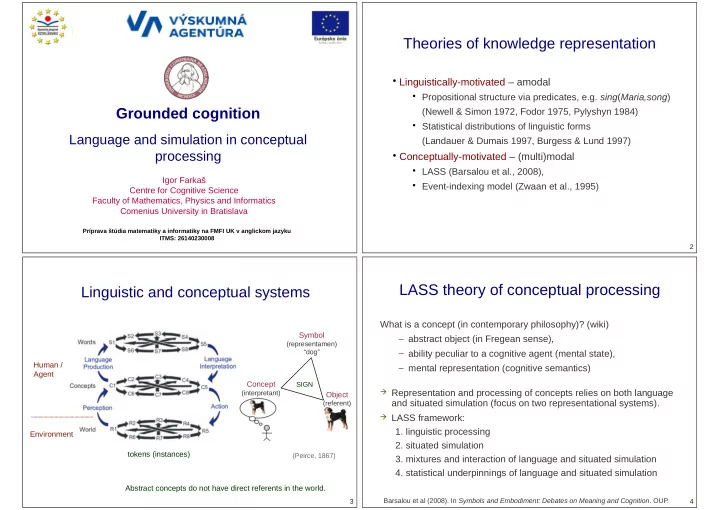

Theories of knowledge representation • Linguistically-motivated – amodal • Propositional structure via predicates, e.g. sing ( Maria,song ) Grounded cognition (Newell & Simon 1972, Fodor 1975, Pylyshyn 1984) • Statistical distributions of linguistic forms Language and simulation in conceptual (Landauer & Dumais 1997, Burgess & Lund 1997) processing • Conceptually-motivated – (multi)modal • LASS (Barsalou et al., 2008), Igor Farkaš • Event-indexing model (Zwaan et al., 1995) Centre for Cognitive Science Faculty of Mathematics, Physics and Informatics Comenius University in Bratislava Príprava štúdia matematiky a informatiky na FMFI UK v anglickom jazyku ITMS: 26140230008 1 2 1 2 LASS theory of conceptual processing Linguistic and conceptual systems What is a concept (in contemporary philosophy)? (wiki) Symbol – abstract object (in Fregean sense), (representamen) – ability peculiar to a cognitive agent (mental state), “dog” Human / – mental representation (cognitive semantics) Agent Concept SIGN Representation and processing of concepts relies on both language (interpretant) Object and situated simulation (focus on two representational systems). (referent) LASS framework: 1. linguistic processing Environment 2. situated simulation tokens (instances) (Peirce, 1867) 3. mixtures and interaction of language and situated simulation 4. statistical underpinnings of language and situated simulation Abstract concepts do not have direct referents in the world. Barsalou et al (2008). In Symbols and Embodiment: Debates on Meaning and Cognition . OUP. 3 4 3 4
Linguistic and conceptual processing in LASS LASS theory – sensitivity to statistics • Assumption: When a word is perceived, LS and SS become active initially, but representations of Both systems are exquisitely sensitive to the statistical structure of linguistic forms peak first. their respective domains: • After the word is recognized, associated linguistic Simulation system (SS): simulators capture the statistical frequency of forms are generated as inferences and as properties and the relation between them in experience. pointers to associated conceptual information. Linguistic system (LS): frequency of words, associations between them and their relations to syntactic structures are coded statistically. ● Linguistic strategies are relatively superficial: may be sufficient for some tasks, when no retrieval of deeper conceptual information is Statistical structures in the two systems roughly mirror each other. necessary (e.g. lexical decision task). Neural architecture naturally stores extensive amounts of statistical ● Meaning is largely represented in the simulation system. information. ● The two systems interact ● they are not modular systems 5 6 5 6 Mixtures of two systems – property generation Mixtures of two systems – word association Task: Receiving a word and generating properties verbally (15 sec.) Task: Receiving a word and generating associated words production of less linguistic response and more object-situation ● ● Linguistically related response response linguistic response precedes object-situation response ● Taxonomically related response ● ● Object–situation response Property generation with fMRI: (Simmons et al, 2008) Word association localizer: activation in Broca’s area, left inferior LASS predictions: (Santos et al, 2008) temporal gyrus and right cerebellum Linguistically related responses are produced earlier than Situation localizer: activation in the precuneus (part of superior object-situation response. parietal lobule) and right middle temporal gyrus Responses that are more likely to originate in LS occur earlier SS appears responsible for responses produced during the late than responses that are more likely to originate in SS. phase of property generation. Taxonomic response falls halfway in between. 7 8 7 8
Mixtures of two systems – Abstract concepts Mixtures of two systems – property verification Task: given an abstract word for 5 seconds and then verifying whether the concept applies to a subsequent picture (Wilson et al, 2008) . Task: Receiving an object name and then verifying whether a e.g.: ‘convince’ – picture of a politician speaking to a crowd ● subsequently presented property was part of the respective Result: object. ‘convince’: activation of brain areas involved in representing mental states ● Linguistic strategy: assess whether the object and property and social interaction (e.g. medial prefrontal cortex) word are associated: fast linguistic strategy ‘arithmetic’: activates brain areas involved in performing arithmetic ● Simulation strategy: part relation linking the object and property operations (e.g. intraparietal sulcus) concepts must be found: slow simulation strategy • In both cases, SS involved, LS not more active than for concrete words. fMRI: When task condition requires deeper conceptual processing, participants rely on SS. Related false trials force using simulation strategy: activation of left fusiform gyrus Representation of abstract concepts can difgerently recruit LS and SS. 9 10 9 10 Summary Relation of LASS to earlier theories ● Paivio (1971) – dual-coding theory (of cognition) ● Conceptual system already evolved in nonhuman species ● assumes analogue (images) & symbolic (words) codes ● Added value of (complex) linguistic processing in ● partially consistent with LASS, since DCT ➢ producing compositional structures of simulations ● assumes deep processing in both systems ➢ communicating non-present situations ● postulates LS as central ➢ coordinated simulations (social organization) ● Glaser (1992) – lexical hypothesis ● linguistic system = control system (?) ● LS can perform superficial processing independently of the ● nonlinguistic stimuli vs verbal cues conceptual system (i.e. LH) ● Importance of statistical sensitivity ● Concetual system may not contain modal representations ● None of the systems alone sufficient for symbolic behavior 11 12 11 12
Recommend
More recommend